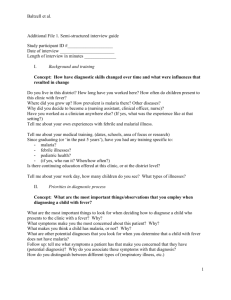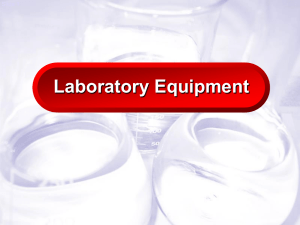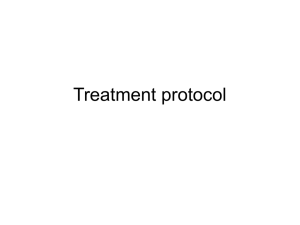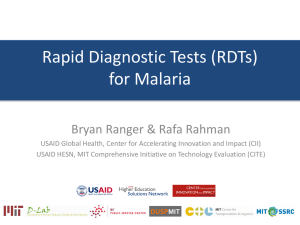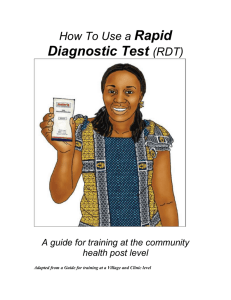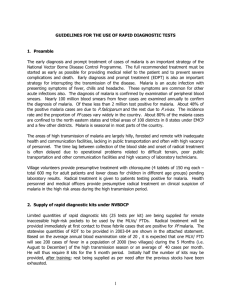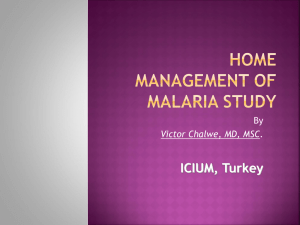Laboratory protocol
advertisement
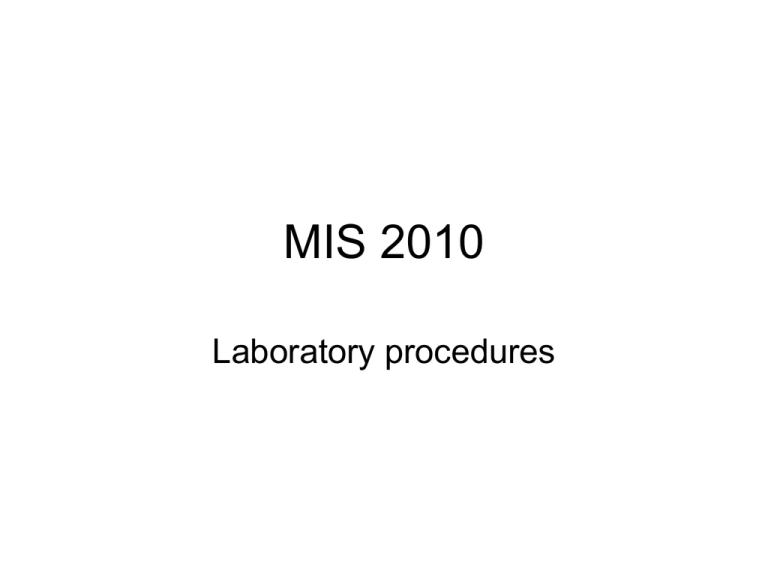
MIS 2010 Laboratory procedures Introduction • During the MIS patients are tested for Anemia • using a hem cure 201+ • Malaria parasites using • RDTs (ICT Mal Pf) • Thick blood films stained in Geimsa 3% • Dried spots will be used • to resolve on discordant results • Serology testing for malaria transmission intensity • Other molecular amplification methods like LAMP Tests per client • • • • Hemoglobin estimation RDTs test for P.falciparum Thick blood film Blood spot on a filter paper Requirements for the four tests • General • • • • Un used gloves Alcohol swab, Lancet Sharp disposal box General disposal bucket with a bin liner • Anemia • Hemocue analyzer, Microcuvette • Malaria Testing by RDTs • Testing device, Sucking blood • Malaria testing by blood film • Microscope slide • Slide box carrier • Slide making template • Serology and molecular analysis • Filter paper • Descant • Medicine pack Blood collection procedure • • • • Clean the ring finger appropriately with an alcohol swab Using a sterile lancet gently prick the finger Put two normal drops on the centre of slide From the same finger stick put a drop of blood on each circle/square on the provided filter paper • From the microscope slide • Fill the microcuvette for HB estimation • Suck the blood using the provided sucking bulb for RDTs testing in the kit to the right first mark • The remaining blood on the slide is spread evenly using the provided template to make an even thick film How to make a finger stick • Assemble all the requirements for the four tests • Hb,malaria test (RDTs &BF), serology testing and molecular analysis (PCR & Lamp) • Put on new un-used gloves • Clean the ring finger with an alcohol swab let it air dry • Open a new un-opened sterile lancet from the RDT kit and use it to make a finger stick • Without putting it on the floor or table discard it directly in the sharp box. Blood collection • Label the microscope slide, RDT testing device, medicine pack and filter paper with the client ID. • Put two drops of blood on the centre of the microscope slide. • Put additional drops of blood on each of the circles/squares on the filter paper. Hemoglobin testing • Turn on the Hemocue • Open the sample rack • Fill first the microcuvette from the two drops on the microscope slide • Clean the microcuvette and put it in the Hemocue • Read and report the results when displayed. Malaria testing-RDTs • Suck blood from the centre of the microscope slide to the first mark of the sucking bulb in the RDT kit • Dispense the sucked blood on the sample well by touching-blotting • Add five drops of buffer on the buffer well • Wait for 15 minutes • Read, and report the results • Keep the used RDT cassette for QC Malaria testing-BF • From the remaining blood after anemia and RDTs testing, • Spread it over the area as indicated by the slide making template • Keep it on a flat surface to air dry • Store air dried blood films in the slide carrier box. • Blood films should be stored properly following the patient name, IDs ,dates and enumeration areas Blood spots • Let each drop of blood on each circle completely air dry for a day protected from the dust and insects in the slide carrier box • Puck them in a well labeled with client IDs medicine pack with a descant • Enter or tick the specimens successfully collected on the specimen sheet provided. • Ensure that this is verified by all team members How to do lab procedures • Follow Hemocue manufacture instructions • Follow RDTs instructions sheets Specimen dispatching • All the specimens will received by one of the four laboratory supervisors only. • No one should just leave the specimens with anyone without verification and signing in the specimen receiving register for each laboratory supervisors. • All the four specimens (slide, RDT, filter paper, anemia test result) will be checked for labeling ,presence or absence and collect collection. • Each enumeration area will have its own slide carrier and all the specimens bundled together with the daily specimen collection sheets in one place. Specimen Storage • Slides will be stained at NMCC • Examined and results report at NMCC • Filter papers will be stored at 4 degree Celsius before molecular and serology analysis at a selected institution.
